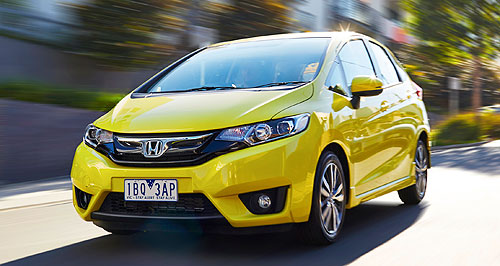New models - Honda - JazzDriven: Jazz to hit high note for HondaFeeling Jazzy: The new Honda Jazz kicks off from $14,990 plus ORCs and tops out with the automatic VTi-L from $22,490. Third-gen Honda Jazz arrives tasked with clawing back sales in light car segment29 Jul 2014 HONDA Australia predicts its third-generation Jazz will return the light hatch to its previous best sales form that saw it place among the top five models in its segment. The Japanese brand’s key volume-selling model has fallen behind its main rivals in recent years, and in 2013 sunk to less than 5800 units – down 37 per cent on the previous year and its lowest full-year result since the Jazz arrived in Australia in 2002. Over the past decade Honda Australia had routinely shifted between 7500 and 9500 examples of the light car each year, peaking at 11,663 in 2007 when the brand also posted record overall sales of more than 60,000 units. This year, Jazz sales have fallen a further 45.5 per cent in the first six months of trading, with less than 2000 new registrations for the period. The light-car segment is struggling, but the market-leading Hyundai i20 has nonetheless racked up almost 8000 sales year to date, with the Toyota Yaris and Mazda2 both beyond 6500 units in the first half. Speaking with GoAuto at the launch of the redesigned Jazz on the Gold Coast this week, Honda Australia director Stephen Collins said the company expected consistent sales growth from the new-generation model, and was confident it could return to its previous levels. “We want to sell a minimum of 800 a month,” he said, which equates to 9600 a year. “For us that well and truly makes it what we would call a core model. “So we think in that light hatch segment, which I think is about 100,000 units a year, that’s sort of where we should be. With the product package and value-for-money equation there is no reason we can’t do that, if not more.” With the Civic range averaging between 700 and 1000 units per month this year and the CR-V regularly shifting about 900, Mr Collins said the Jazz could potentially become the brand’s top-seller in Australia. “I can’t see any reason why not. Our two top sellers are CR-V and Jazz. CR-V is probably doing 900 a month now. It certainly has the potential to be our top-selling model. It’s a big segment and Jazz has got a great name. If we are selling more than 800 I will be happy.” The Jazz already faces tough competition in the ultra-competitive light car segment, and it is about to get even tougher with the all-new Mazda2 arriving in October, followed by the heavily upgraded Kia Rio late this year. The major upgrade for the Yaris arrives in September, about the same time as the facelifted Volkswagen Polo, while the i20 receives a midlife overhaul in the first half of next year. Despite the onslaught of new or updated rivals, Mr Collins said the packaging and pricing of the Jazz should ensure it remains a popular choice in the segment. “There are plenty of good cars in that segment. We think we can attract two types of buyers. Our traditional Jazz buyer is middle-aged. We think this Jazz will be very good for the loyalists. But particularly for a younger demographic, we have specced it very well, we have put a lot of connectivity in it, such as reversing camera. All the gear those 20 to 30-year-olds, particularly females, are looking for. “We think that’s what’s going to differentiate it. It’s highly specced, it’s good value for money, it’s a great package. It’s probably the best all-rounder in that class.” Mr Collins also dismissed the suggestion that Jazz sales could be affected by the arrival of the Jazz-based HR-V compact crossover early next year. “I think they will complement each other. I think HR-V is going to appeal more to small hatch buyers rather than light hatch buyers. I don’t think there will be much crossover with Jazz. If anything it might be more with Civic hatch,” he said. Honda announced pricing for the new Jazz in June, confirming a three variant line-up kicking off with the base VTi in manual guise from $14,990 plus on-road costs. This matches the opening price of the previous base GLi, but is a $1000 drop over the outgoing Jazz Vibe which has acted as the range opener in recent months. Opting for the continuously variable transmission (CVT) – developed under Honda’s ‘Earth Dreams’ green technology banner – adds $2000 to bring the VTi to $16,990. The VTi is the only Jazz available with a five-speed manual gearbox, with all other models in the range relying solely on the CVT. The opening price for the Jazz undercuts a number of popular light-sized hatches, including the Ford Fiesta Ambiente ($15,825), Mazda2 Neo ($15,790), Yaris YR five-door ($15,690) and Suzuki Swift GL ($15,990). It matches the price of the Holden Barina CD. The mid-spec VTi-S is priced from $19,790 – a $1200 drop compared with the outgoing VTi-S – while a new range-topper, VTi-L, starts at $22,490. Honda’s existing petrol-electric Jazz Hybrid will soldier on alongside the new series, with the third-generation version not slated to arrive in Australia until next year. Measuring 3996mm in overall length, the new Jazz is 76mm longer than the outgoing model, and the wheelbase has been stretched by 30mm to 2530mm. It is 1mm lower (1524mm) and 1mm narrower (1694mm) than before. Honda says the use of a lower-profile fuel tank and a narrower radiator fan in the engine bay has liberated more interior room. This has ensured the already versatile cabin is now even more so, with the ‘Magic Seats’ offering 18 different configurations, while a new rear wheelarch design and shorter suspension trailing arm has increased rear legroom by 36mm. The 1.5-litre four-cylinder i-VTEC petrol engine is carried over from the previous model, although Honda says a number of improvements have been made. Power and torque stay the same, with the Jazz still producing 88kW and 145Nm, which is similar to the 1.4-litre MPI unit in the Rio (79kW/135Nm) and roughly the same as the 1.5-litre unit under the bonnet of the Fiesta (82kW/140Nm). The Jazz VTi in five-speed manual guise consumes 6.2 litres of petrol per 100km on the combined cycle, which is a 0.2L improvement over the previous model. When matched with Honda’s new Earth Dreams CVT, fuel economy over the outgoing five-speed automatic is improved by 0.9L to 5.8L/100km – a figure which matches the 1.5 Fiesta and undercuts the Rio by 0.5L. Honda says the improved economy figures are due to the reduced weight of a number of components, among other improvements. The Jazz also features an Eco Assist function on CVT models, which highlights fuel-saving measures such as smooth acceleration and braking via a glowing green meter housed within the speedo. The Econ button that is a fixture on most current-generation Hondas can also help reduce fuel consumption through changes to the transmission and engine. The Japanese car-maker says the new Jazz is built using the company’s Advanced Compatibility Engineering (ACE) body structure, which is said to improve safety, while the platform is lighter and more rigid than before. The new body frame has also helped refine noise, vibration and harshness (NVH) levels in the Jazz, with the stiffer frame making for better sealing, while sound-proofing materials in the ceiling, doors, floor, dash and instrument panel have had a positive impact on cabin noise. Mechanical changes to improve ride and handling include a new rear damper design, a high-rigidity torsion beam rear suspension set-up, new front suspension struts as well as front and rear roll centre height changes. The steering has also received attention, with tweaks such as solid mountings and a bigger-diameter column shaft making for less vibration and more direct steering. Improved throttle response, more efficient transmissions and reduced aerodynamic drag has made for a quicker Jazz, according to Honda, however performance figures have not been provided to compare with the outgoing model. Design-wise, the Jazz takes on a slightly more rounded look to its predecessor, but also gains two separate character lines running through the front and rear doors, while the front-end styling falls into line with Honda’s current design direction already seen on the Civic hatch, CR-V SUV and mechanically related City sedan. Starting with the base VTi, standard features include LED headlights and tail-lights, black fabric seat trim, height- and reach-adjustable steering wheel, four-speaker stereo, a 12-volt power outlet and 15-inch steel wheels. It also features Honda’s Display Audio which includes a seven-inch touchscreen, the reversing camera, AM/FM radio, CD player, Bluetooth connectivity, two USB ports, Siri Eyes-free mode for Apple iPhone, HDMI port and MP4 movie file capability. Moving up to the mid-spec VTi-S adds premium fabric on the seats, electric folding door mirrors, foglights, side skirting, climate-control air-conditioning, a security alarm, 16-inch alloy wheels, a six-speaker stereo, chrome flourishes around the rear licence plate and luxury touches such as leather-wrapped steering wheel and gearshift knob. Range-topping VTi-L variants gain black leather-appointed trim, heated front seats, rear parking sensors, keyless entry/start, a rear centre armrest and a tailgate spoiler. On the safety front, the Jazz features ABS brakes (with electronic brake-force distribution and brake assist), hill-start assist, an emergency stop signal, electronic stability and traction control, six airbags, a side-impact protection system and a reversing camera as standard across the range. The new Jazz is yet to be crash-tested by ANCAP, but is expected to retain the current model’s top five-star rating. 2014 Honda Jazz pricing*
 Quick testsRead more12th of June 2014  Next-gen Honda Jazz here next monthHonda’s third-gen Jazz priced from $14,990 plus ORCs with sharp new line-up22nd of April 2014  New York show: Return of the Honda HR-VHR-V name returns to Honda showrooms on Jazz-based crossover due in early 2015Jazz pricingMotor industry news |
|
||||||||||
































Facebook Twitter Instagram